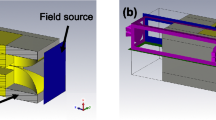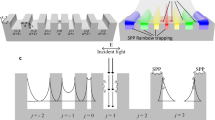Abstract
In this paper, we demonstrate an approach to couple freely propagating THz pulses onto a metal wire waveguide utilizing grating as various shaped grooves; rectangular, triangular and circular grooves fabricated directly into the metal. Using broadband THz pulses incident on the wire, we use metal segments containing number of uniformly, symmetric spaced grooves around subwavelength aperture to launch surface propagating multi-cycle pulses along the wire. THz radiation detected at the end of the waveguide with grooves showed overall improved signal amplitude and increased bandwidth as compared to that for the non-machined waveguide. We observe a one-to-one correspondence between the groove number and the number of oscillations in the THz wave form radiated from the end of the waveguide. We further demonstrate that this coupled radiation is radially polarized. Although the alteration of cross-sectional parameters of the grooves, the shape of the individual grooves, in a controlled manner should allow for arbitrarily shaped THz pulses to be launched on the waveguide, all of which compared to rectangular grooves’ output signal and the efficient shaped groove has been chosen.









Similar content being viewed by others
References
Agrawal, A., Cao, H., Nahata, A.: Excitation and scattering of surface plasmon-polaritons on structured metal films and their application to pulse shaping and enhanced transmission. New J. Phys. 7, 249 (2005a).
Agrawal, A., Cao, H., Nahata, A.: Time-domain analysis of enhanced transmission through a single subwavelength aperture. Opt. Express 13, 3535–3542 (2005b). http://www.opticsexpress.org/abstract.cfm?URI=OPEX-13-9-3535
Cao, H., Agrawal, A., Nahata, A.: Controlling the transmission resonance lineshape of a single subwavelength aperture. Opt. Express 13, 763–769 (2005). http://www.opticsexpress.org/abstract.cfm?URI=OPEX-13-3-763
Cao, Q., Jahns, J.: Azimuthally polarized surface plasmons as effective terahertz waveguides. Opt. Express 13, 511–518 (2005). http://www.opticsexpress.org/abstract.cfm?URI=OPEX-13-2-511
Cao, H., Linke, R.A., Nahata, A.: Broadband generation of terahertz radiation in a waveguide. Appl. Phys. Lett. 29, 1751–1753 (2004)
Coleman, S., Grischkowsky, D.: A THz transverse electromagnetic mode two dimensional interconnect layer incorporating quasi-optics. Appl. Phys. Lett. 83, 3656–3658 (2003)
Coleman, S., Grischkowsky, D.: Parallel plate THz transmitter. Appl. Phys. Lett. 84, 654–656 (2004)
Collin, R.E.: Field Theory of Guided Waves. IEEE, New York (1991)
Gallot, G., Jamison, S.P., McGowan, R.W., Grischkowsky, D.: Terahertz waveguides. J. Opt. Soc. Am. B 17, 851–863 (2000)
Gordon, R., Brolo, A.G., McKinnon, A., Rajora, A., Leatham, B., Kavanagh, K.L.: Strong polarization in the optical transmission through elliptical nanohole arrays. Phys. Rev. Lett. 92, 037401 (2004)
Goto, M., Quema, A., Takahashi, H., Ono, S., Sarukura, N.: Teflon photonic crystal fiber as terahertz waveguide. Jpn. J. Appl. Phys. 43, L317–L319 (2004)
Goubau, G.: Surface waves and their application to transmission lines. J. Appl. Phys. 21(11), 1119–1128 (1950)
Goubau, G.: Single-conductor surface-wave transmission lines. Proc. IRE 39, 619–623 (1951)
Han, H., Park, H., Cho, M., Kim, J.: Terahertz pulse propagation in a plastic photonic crystal fiber. Appl. Phys. Lett. 80, 2634–2636 (2002)
Harrington, J. A., George, R., Pedersen, P., Mueller, E.: Hollow polycarbonate waveguides with inner Cu coatings for delivery of terahertz radiation. Opt. Express 12, 5263–5268 (2004). http://www.opticsexpress.org/abstract.cfm?URI=OPEX-12-21-5263
Jamison, S.P., McGowan, R.W., Grischkowsky, D.: Single-mode waveguide propagation and reshaping of sub-ps terahertz pulses in sapphire fiber. Appl. Phys. Lett. 76, 1987–1989 (2000)
Jeon, T.-I., Zhang, J., Grischkowsky, D.: THz Sommerfeld wave propagation on a single metal wire. Appl. Phys. Lett. 86, 161904/1–161904/3 (2005)
Maier, S.A., Andrews, S.R., Martin-Moreno, L., et al.: Terahertz surface plasmon-polariton propagation and focusing on periodically corrugated metal wires. Phys. Rev. Lett. 97(17), 176805-1–176805-4 (2006).
McGowan, R.W., Gallot, G., Grischkowsky, D.: Propagation of ultrawideband short pulses of THz radiation through submillimeter-diameter circular waveguides. Opt. Lett. 24, 1431–1433 (1999)
Mendis, R., Grischkowsky, D.: Plastic ribbon THz waveguides. J. Appl. Phys. 88, 4449–4451 (2000)
Mendis, R., Grischkowsky, D.: Undistorted guided-wave propagation of subpicosecond terahertz pulses. Opt. Lett. 26, 846–848 (2001)
Shen, L., Chen, X., Zhong, Y., et al.: Effect of absorption on terahertz surface plasmon polaritons propagating along periodically corrugated metal wires. Phys. Rev. B 77(7), 075408 (2008)
Sobel, F., Wentworth, F.L., Wiltse, J.C.: Quasi-optical surface waveguide and other components for the 100-to 300-Gc region. IRE Trans. Microwave Theory Tech. 9, 512–518 (1961)
Sommerfeld, A.: Electrodynamics, pp. 177–190. Academic, New York (1952)
Wang, K.L., Mittleman, D.M.: Metal wires for terahertz wave guiding. Nature 432(7015), 376–379 (2004)
Zhu, W.Q., et al.: Planar plasmonic terahertz guided-wave devices. Conference on Lasers and Electro-Optics and Quantum Electronics and Laser Science Conference 2009, pp. 1722–1723 (2009).
Author information
Authors and Affiliations
Corresponding author
Appendix
Appendix
Upon solving the boundary conditions that Ez and Hϕ are continuous at the surface of the conductor which is consistent for r = a, the following equations are obtained for which γc, γ and h can be determined.
To deduce γ c , γ and h from the above equations, Goubau used different approximations, one of which is to consider that the radius of the conductor is large compared to the skin depth of the metal (γca ≫ 1). For example at 1 THz, copper wire of radius 600 μm, the skin depth of the metal is 0.07 μm. Z0 and Z1 in Eq. (0.8) can be replaced by,
Upon approximating that the conductor radius is not too large, i.e. (γca ≪ 1) than we can replace H0 and H1 as,
Thus Eq. (9) is simplified to,
where \(\cot \left( {\gamma_{c} a - \frac{\pi }{4}} \right)\) approaches +j since γc becomes complex. Now, Eq. (15) can be written as:
Rights and permissions
About this article
Cite this article
Ghatei Khiabani Azar, H., Rasouli Saghai, H. Manipulating frequency-dependent diffraction, the linewidth, center frequency and coupling efficiency using periodic corrugations. Opt Quant Electron 48, 464 (2016). https://doi.org/10.1007/s11082-016-0726-4
Received:
Accepted:
Published:
DOI: https://doi.org/10.1007/s11082-016-0726-4




